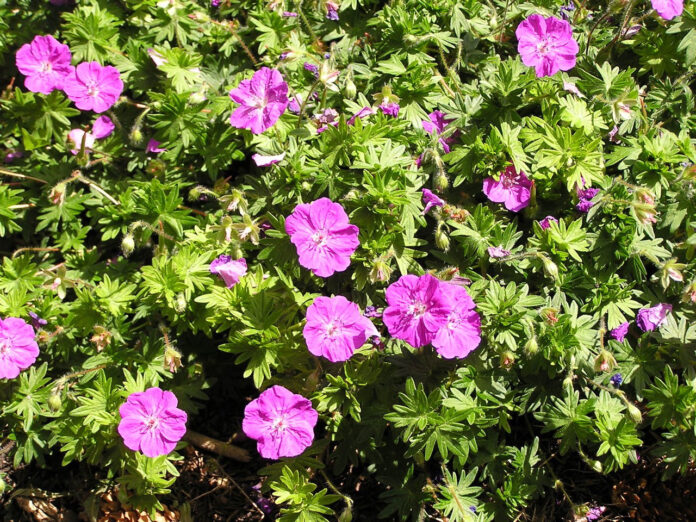Sara Williams
Perennial geraniums (Geranium spp.) go by the common names of cranesbill or geranium. (These are not to be confused with the annual bedding plant, also called a geranium, but in the genus Pelargonium.). The genus Geranium includes more than three hundred species widely distributed in the temperate regions of the world. Only about a dozen of these have proven reliably hardy on the Canadian prairies, but though small in number, they have become a mainstay of our gardens.
Geranium comes from the Greek geranos, meaning crane, referring to the seed capsule that resembles the beak of a crane. The seeds are forcibly expelled from the capsule, scattering them widely.
In mounds or mats ranging in height from 20 to 60 cm (8-24 in.) or more, geraniums have mostly basal-lobed or divided leaves. The five-petaled, cup-shaped flowers appear singly or in clusters, mostly in early and mid-summer, in pastel shades of pink, blue, and purple as well as red, magenta and white. They are long-lived and long-flowering.
Generally of easy care, perennial geraniums do well in ordinary but well-drained soil in full sun to partial shade. Many are moderately drought-tolerant once established. They may be pruned back after flowering for a neater appearance. Most are well placed in a border or rock garden. Some make excellent ground covers. They are easily increased through spring division, by terminal cuttings, or by seed.
Lilac cranesbill (G. himalayense) is native to Sikkum, India, and spreads by short rhizomes. It has some of the largest flowers of all species, lilac-blue to deep blue with purple veins, and is from 30 to 50 cm (12-20 in.) in height. It blooms in summer.
‘Johnson’s Blue’ (G. himalayense x G. pratense) was selected in 1950 by A. T. Johnson of North Wales, who wrote A Garden in Wales (1927). It is very hardy and dependable but somewhat sprawling. It is 30 to 45 cm (12-18 in.) high with 4 to 5 cm (1.6-2.0 in.) blue flowers, borne profusely over a long period in late spring and early summer. It spreads by stolons and is better used as a ground cover. Sterile, it sets no seeds.
Iberian cranesbill (G. ibericum) is native to Turkey and the Caucasus. It is 45 cm (18 in.) in height, vigorous, hardy and drought tolerant, with upward-facing, violet-blue flowers with notched petals in early summer. It can become somewhat weedy and is best used as a ground cover.
Big root geranium (G. macrorrhizum), native to the subalpine woodlands and rock scree of the Alps and Carpathian Mountains of Europe, was introduced to England by 1576. The word macrorrhizum means big root and, like the common name, refers to the thick, fleshy rhizomes, which soon form dense, weed-proof mats. It forms a wide-spreading, bushy mound of 20 to 40 cm (8-15 in.), with pink flowers from late spring to early summer. The lobed, aromatic foliage, which turns red in the fall, was once used medicinally, for tanning, as well as for oil of geranium in the perfume industry-its fragrance is very distinctive when the leaves are crushed. It is both shade and drought tolerant. ‘Ingwersen’s Variety’ has pink, darker veined flowers, 5 cm (2 in.) in diameter. ‘Album’ has white flowers with pink to red calyxes. ‘Bevan’s Variety’ is reddish purple and about 30 cm (12 in.) in height.
Bloody cranesbill or blood red geranium (G. sanguineum) is native to the sea cliffs and sand dunes of England as well as Europe and western Asia. Originally grown for medicinal purposes, it was once used as a healing salve. It forms sturdy clumps or low mounds of dark green, deeply divided foliage, 20 to 45 cm (8-18 in.) in height with a 60 cm (24 in.) spread. Solitary, magenta-red flowers bloom from late spring to early summer. The dark green foliage turns rusty orange to red in fall. Its tough, fleshy rhizomes lend it drought tolerance. It is well placed in a rock garden or used as a ground cover.
‘Album’ is white and a bit taller with a looser habit. ‘Alpenglow’ is 20 cm (8 in.) high with vivid rose-red flowers. ‘Lancastriense’ (syn. var. ‘Striatum’) is a dwarf plant, forming a prostrate mound of 25 to 30 cm (10-12 in.), with pale, salmon pink flowers with deeper pink veins, blooming for a long season. ‘Max Frei’, a German introduction, is a compact plant of only 20 to 25 cm (8-10 in.) with reddish-purple to deep magenta flowers and good autumn foliage colour. ‘New Hampshire Purple’, 20 to 30 cm (8-12 in.) in height, has purple flowers in early summer and bronzy fall foliage.
Sara Williams is the co-author, with Bob Bors, of Growing Fruit in Northern Gardens.
This column is provided courtesy of the Saskatchewan Perennial Society (SPS; saskperennial@hotmail.com ). Check our website saskperennial.ca) or Facebook page (facebook.com/saskperennial). All Saskatchewan Perennial Society events are on hold until further notice.


